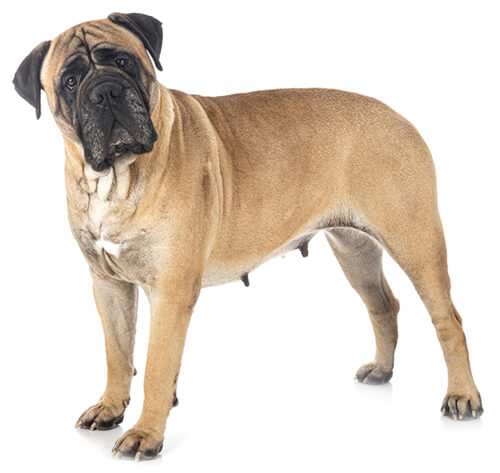
Grand and dignified, the Mastiff is believed to have originated in Asia. A giant breed, he was bred in England as a watchdog for more than 2,000 years. Powerful, good-natured and docile, the Mastiff is a gentle, loyal companion best-suited for suburban or country life due to his size. Mastiffs require light exercise and minimal grooming.
DID YOU KNOW? Famous Mastiff owners include King Henry VII, Marlon Brando and Bob Dylan.
ALSO KNOWN AS: Molosser
The need-to-know
- Dog suitable for experienced owners
- Extra training required
- Enjoys active walks
- Enjoys walking one to two hours a day
- Giant dog
- Some drool
- Requires grooming once a week
- Non hypoallergenic breed
- Chatty and vocal dog
- Guard dog. Barks, alerts and it's physically protective
- May require training to live with other pets
- May require training to live with kids
Personality

Despite their often violent past, the Mastiff is a calm, gentle and noble dog that is devoted and loving towards their family - often thinking of themselves as a lap dog! They are however indifferent or even suspicious of strangers - human or canine.
History and Origins

Country of Origin: England
One of the ancient breed types, Mastiff-like dogs have been known in England since before Roman times having been brought to the UK by Phoenician traders. The conquering Romans were so impressed with these powerful fighting dogs that could best any of their own dogs that they adopted them and used to fight in the arenas and in the Colosseum. As they were the only tame animals to fight in the Colosseum where everything else was wild (such as lions), this is where it is said their name originated from (the Roman word ‘mansuetus’ means ‘tame’).
Over the centuries, the Mastiff was used as a powerful guard dog but also for wolf hunting, bear and bull baiting and dog fighting. When these heinous pursuits were banned in 1835, the future of the breed looked uncertain and by the end of the second World War, there were only 14 left in the UK. Thankfully enthusiasts who recognised the gentle and noble nature of the breed imported Mastiffs from the US and re-established the breed but they are still uncommon.
Nutrition and Feeding

Giant-breed dogs, as well as having giant appetites, benefit from a balanced diet with different nutrients, including minerals and vitamins aimed at supporting different joint and cartilage needs. The Mastiff is prone to bloating and stomach problems; try feeding smaller, more frequent meals to help minimise the risk.
Exercise

The Mastiff dog breed needs about an hour's exercise a day and are inclined to be quite lazy, enjoying a good snooze in a comfortable, warm spot and enjoy a sunny garden. Do not over-exercise when young, as the breed is prone to skeletal problems, which can be exacerbated by muscle and joint strain in a growing dog.
Other Information

Health and Common Concerns
As with many breeds, Mastiff dog breeds can suffer from various hereditary eye disorders, and hip and elbow dysplasia (joint conditions that can be painful and lead to mobility problems). Eye testing and hip scoring of dogs prior to breeding is therefore important. They are also prone to a particular bladder condition and ligament problems in the knee (cruciate disease).
Space Requirements
This is a giant dog who is by nature protective of his people and his perceived territory. As such he needs a large house and a large, well-fenced garden along with access to quiet open areas for exercise.
Training Mastiff Dogs
While the Mastiff has little interest in dog training, they should be socialised when young and like any giant powerful dog, should be taught to walk on a lead and harness. A good recall should be taught but because of his sheer size, most exercise is likely to be on lead to ensure the safety of other dogs and people.
Best Family Dog Breeds
The Mastiff is devoted to their own families but they are so big and powerful that they are not idea with small children - and they can mistake the intentions of children’s playful friends. While many dogs are traditionally thought of as being good with children, all dogs and children need to be taught to get on with each other and be safe together. Even so, dogs and young children should never be left alone together and adults should supervise all interactions between them.
Did You Know?
- The Mastiff is one of the most ancient and valued breeds (for hunting, guarding and as war dogs) - and many countries in the world have their own versions.